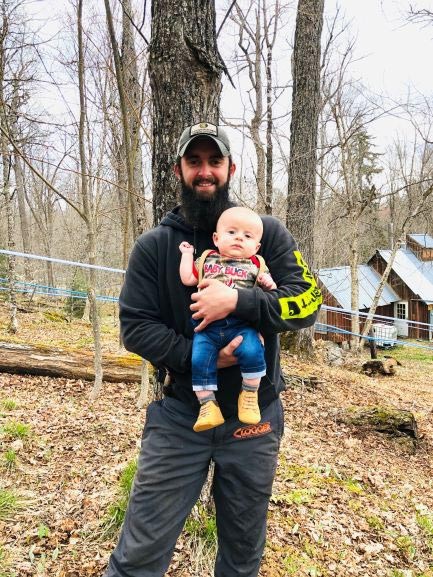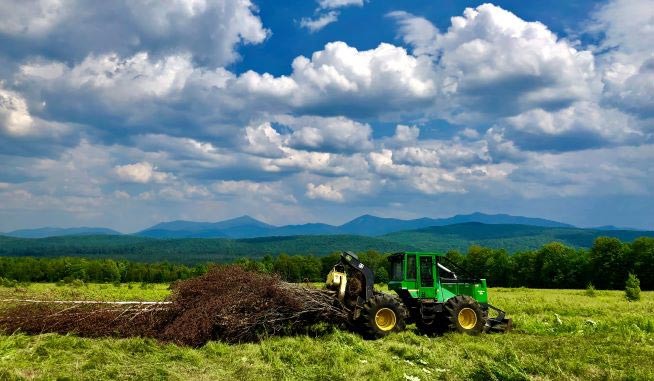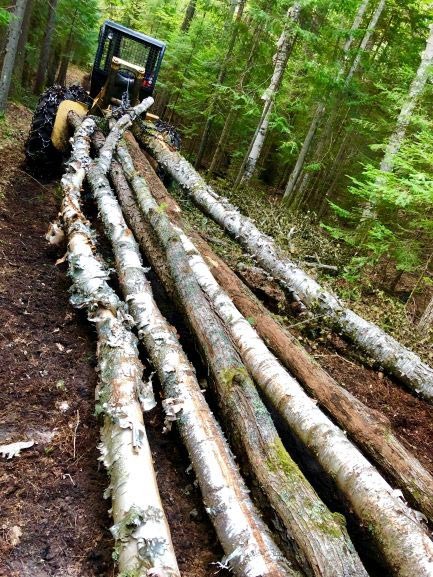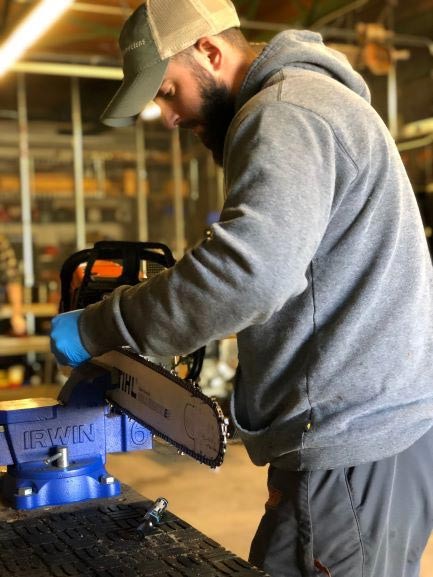Jim Hayner is an Army veteran, a new dad, and a student at Paul Smith's College in the Adirondacks, where he’s majoring in ecological forest management. He’s also the veteran coordinator for the college’s Troops to Timber initiative, which connects veterans to the forestry program at Paul Smith’s. And he’s a member of the school’s Microenterprise Crew, which provides a hands-on approach to learning about forestry and logging. Jim’s connection to the woods is generations deep: both his grandfather and father worked as loggers, making a life and a living from the forest.
I grew up in the southern foothills of the Adirondack Mountains, in Gloversville and Johnstown. My dad was and still is an avid whitetail hunter and fisherman, so he had us out enjoying the Adirondacks before we could walk. I specifically remember going fishing in some remote places that not many people knew about in the southern Adirondacks and having a lot of success trout fishing small ponds and streams. I still get my (hunting) license every year. My dad lives about three hours away right now, but we meet in the middle sometimes, or he’ll come up here or I’ll go down there, and we’ll hunt together.
My brother and I were outside all day for as long as I can remember. That’s all we really did – ice fishing, fishing, camping, hiking, whitetail hunting, turkey hunting. I was always out in the woods. Being out in the middle of nowhere in the Adirondacks, likely miles from anyone else, gives you this primal sense of freedom and liberation that I have yet to encounter anywhere else in my life. I never focused on the trees themselves as much as I do now, but just being out there, taking in the sights, sounds, and smells will always be my go-to for a mental reset.
I went to Fulton-Montgomery Community College in Fulton County, New York, right out of high school in 2008. Originally, I went to school for criminal justice. I was looking to be an environmental conservation officer or something along those lines. I was interested in environmental science. I didn’t really know what forestry was.
I joined the military because I was working full time and going to school part time, and as much as I love my hometown, I didn’t want to be there forever. I wanted to get out and see different things and do different things. Sure enough, I went to basic training and advanced training, and then they sent me right to Korea, my first duty station. So I certainly went away from Fulton County. I spent a year in Korea, then three years in El Paso, Texas, a year in Germany, and then a year in Fort Drum, New York.
When I was getting out of the Army, I was undecided about what I wanted to do. I wanted a career that had purpose and meaning to me, and if I could happen to work outside to achieve that purpose and meaning, I thought that would be ideal. In June of 2018, I attended an event called Troops to Timber at Fort Drum, hosted by the forestry professionals of Paul Smith’s College. Brett McLeod, the forestry department chair at the college [and a regular contributor to Northern Woodlands], and Tom Bartiss, the college’s forest manager, put on the event and piqued my interest in forestry. We cut some trees, and we made some wood cookies, and they taught us how to measure standing trees. I knew of Paul Smith’s before the Army. It’s only about two and a half hours from my hometown. I knew it as the lumberjack school. Then they came and did all this lumberjack stuff, and I was like, I want to do it. After a visit to the lakeside campus a month later, it was a no-brainer that I had to attend a school in the middle of the Adirondacks.
I was an air traffic controller in the Army, so it doesn’t really relate at all to forestry. But just the discipline and the maturity is what has made a world of difference. I love my classes and I’ve done well. Because I’m a non-traditional student and I have a military background, I’ve kind of become a leader in a lot of the classes. I like being able to not just learn, but also teach. I’ve been able to do some tutoring. And I was supposed to do a teaching assistant position this summer – I don’t know if we’ll be able to do it now because of COVID-19.
Last spring I was in one of Brett’s classes, and he asked me at the end of the semester if I was looking for some forestry work and sent my name to the Microenterprise Crew. He says it makes you a better forester if you get out and do what a logger would do rather than just learning it from a book. It is a great opportunity to go out and get firsthand experience. It gives you an idea of what you might be looking at with different treatments and what you’re going to be dealing with.
The Crew is typically 5-10 students enrolled in one of the three forestry bachelor’s programs at the college. The members of the crew are hired as college employees. To become a crew member, a student has to demonstrate that he or she has the ability to achieve academic success while being a reliable employee. There is also a prerequisite of completing the summer Forest Production Processes course along with the fall Timber Harvesting course, both taught by Tom Bartiss. During these courses, students learn Game of Logging Level 1 and 2 along with First Aid.
We are tasked with a wide variety of forestry related work ranging from hand felling, skidding, bucking and loading at the current job site, to area beautification for different clients off-campus. Last summer we did a project near Saranac Lake where we removed unwanted brush and small trees in a viewshed of the Mackenzie Mountain Range. We had to go in with a brush hog and a skidder, take out clumps of trees and do some brush hogging for a few days.
Public outreach is an essential responsibility of the crew when we work in places like Paul Smith’s College Visitor Interpretive Center (VIC). Recently we’ve been doing some timber stand improvement type work there, but we’re also harvesting quite a bit of balsam that’s overgrown and spruce that’s overgrown. There’s high visibility there at the VIC. It’s right off Route 30, which is one of the main arteries in the Adirondacks. Everybody can see the skidder and the loader and the landing and everything right there, and there’s lots of tourists who visit. We are often asked questions about why we are cutting trees or what our goals and objectives are for each job. We have to have a genuine understanding of why we’re doing the things we’re doing in the woods.
It’s a good opportunity for us as students to understand that being a forester doesn’t mean you’re just talking to trees all day. You do have a lot of public face-to-face interaction talking to people. You don’t just hang out in the woods all day by yourself. You have to talk to landowners all the time. You have to talk to concerned citizens all the time. This is a great way to get our feet wet with that.
I think we’re going to see a change in species composition because of the warming temperatures. We’ve been talking in my classes a lot about oak hickory forests moving north. In the Adirondacks you typically have a forest of about 14 species. That’s all that can really survive and thrive. But if the temperatures start warming up, and we don’t get those deep freezes anymore in the winter, then things like oak and hickory will start moving up this way. Right now, it’s still good species composition – the 14 main species everywhere, pretty much. I live in Malone, which is just outside the Adirondack park, and I have all sorts of different species outside of those 14 – things like boxelder and fire cherry – just on my one acre of land. I think it’s because of the elevation difference. We’re down off the mountains, sort of the northern foothills.
The college owns a sugarbush, and the sugarbush manager, Jim Brandis, ended up with over 1,200 gallons of syrup this year. I’ve gone in to help him out once in a while this spring. Usually he has a class called Sugarbush Management, and the class is not in session – it’s online now. So he’s doing everything himself. He doesn’t have the 30 students that he normally has there. The other guys on the crew are all home at this point, because they can’t come back to school. I only live half an hour away from campus.
Right now our work with the Microenterprise Crew is on hold. Of course, it’s not essential, technically, because we’re not making products. It’s also not congregating, either. The most congregation we would do would be to grab our chainsaws out of the cabinet and then drive to the site. We could easily stay six feet away from each other if we drove separately to the site. I’m just hoping that day comes when the college president says we can go back to work.
The best part about being in the woods for me is the alone time, mainly. When we’re cutting, we have to be at least two tree lengths away from each other, but usually we’re quite a ways away from each other. We’re kind of in our own element, our own environment. I forget what time it is. I forget what day it is. It’s just a reset for me to go in and spend a day in the woods.






Discussion *